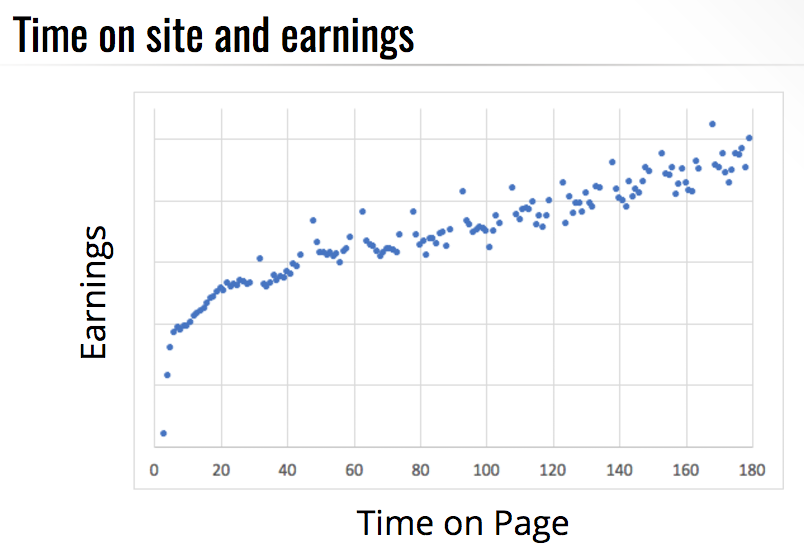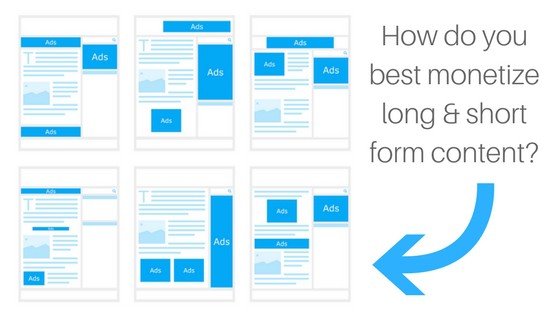Short Form vs Long Form Content Monetization
The debate about short form vs long form content has been raging for years and years. The fact remains that both have relevant roles in the world of digital publishing. A broad brush approach of comparing the two isn’t as productive as discussing how each should be properly monetized and leveraged by digital publishers.

Below, I’ll show you how to use both short form and long form content as tools in an overall basic publishing strategy and highlight how to best monetize both forms of content on a digital property to earn more digital revenue. I’ll show you the actual data behind these strategies and teach you why each offers potential higher earnings.
The right tool for the right job
It’s really easy to get bogged down in which form of content is better for different types of audiences and platforms. I don’t want to waste too much time on this today; as the internet is absolutely flooded with opinions on this. However, I will share with you some data to get you going in the right direction.

Long form content is going to rank better in search engines and is largely a better tool for a long-game organic traffic strategy. This is the approach that many high-quality publishers take. We know this and it has been shown in a number of different areas. Building and accelerating this strategy is something I have been very successful at and something I’ve written about a lot (links below).
- Increasing rankings for your content in search results
- How to write long form content that ranks earns organic traffic
- How to get old content to rank higher in search engines
Conversely short form content may offer some better advantages to certain social media audiences — and in some cases — outlets that lend themselves to answers (Quora) and rich snippets (Google search).
Ultimately, both are often under-monetized because publishers fail to account for how users interact and respond to this content on their site. Here are some facts about user experience you should know before we go any further…
We did an entire web event on this subject in the video below
User experiences affect the value of short & long form content
This is a drum we beat a lot and have talked about a couple of times; however, this perspective is a little different. The basic user experience metrics like pageviews per visit, session duration, and bounce rate play a huge role in the total amount of session earnings that a site generates. Here’s the science behind it…

As you can see above, the amount of time spent on a page directly correlates to the amount of ad revenue generated for a user session. This has nothing to do with long or short form content.
Some might look at this and say, “clearly long form is better; as people will spend more time reading it, right”? But, that’s not what the data says. That’s a subjective assumption about how you think users will interact with content. The truth is that we’ve found that short form articles can sometimes do a better job extending users sessions; which leads to my next stat.

There are few metrics that affect digital revenue more than pageviews per visit. You can see that there is an exponential correlation between ad revenue and page views for the first few pageviews of a user session. After those initial pageviews, there is a linear progression of earnings associated with additional pageviews.

What’s particularly interesting here is that the progression of earnings does not level off. This is where short form content has some potential benefits over long form content; if the long form content fails to deliver a progressive experience.
In either case, finding ways to extend user sessions is clearly valuable. In most cases being able to influence these metrics on your highest value pages offers serious (and often exponential) potential digital revenue increases.
Better monetize short form content
After seeing the metrics above, the right response to have is, “how do I extend user sessions so that I can make more money”! The initial feeling to turn your entire site into a gallery-style scroll through website may feel attractive, but we’ve seen that it can have the opposite effect in some cases. So, what should you do?

Understand Landing Pages better
Knowing which content is best to link to on particular landing pages can offer some really strong benefits. You can use Google Analytics to decipher some of this by plowing down deep into BEHAVIOR > SITE CONTENT > LANDING PAGES. However, knowing which landing pages earn the most revenue per user session is actually much more valuable.

Furthermore, understanding which landing pages produce the greatest EPMV (earnings per 1,000 sessions) will tell you which content is best at maximizing CPM’s, pageviews and sessions against things like bounce rate.
Knowing which pages these are can tell you more about which pages you should invest in promoting (both paid and organically) and which pages you should be mirroring future pages off of to generate the most digital revenue.
Capture Your readers Quickly
Tools like newsletter forms and social share buttons offer the ability to capture your audience (for whatever time they are there) to stay in touch or to convert them to a social influencer.

These may seem like small things but testing where these are on the page, and featuring them more prominently could offer you the ability to build a newsletter better; allowing you to drive back returning users for more regular pageviews (return visitors often have longer user sessions).
Additionally, configuring something like an exit pop-up on your site offers the ability to capture extra pageviews from between 3-12% (on average) from users that may have previously been leaving your site. It’s good to make sure that these pop-ups are not having an overall negative influence on your site (test and monitor), but worth trying out.
Worried about the Google mobile interstitial penalty? We wrote about how to account for it with pop-ups on your website here.
Extend short content sessions by embedding outside content
Supplement the content with embedded outside content from social media, YouTube, or SlideShare. If your content is short (by intention or by function) it’s worth figuring out if there is a potentially a YouTube video, Slideshare, or social media post that you could potentially embed in the content to increases the session duration of users landing on that page.

It’s not always a great strategy to litter your content with outside material, but in some short form content, it makes a lot of sense if it can help you get that critical first 20+ seconds of a user session.
Better monetize long form content
Step one in monetizing long form content is making sure that it is constructed using a proven formula to extend sessions and draw eyes down the page. You can get most of that in our article about writing articles for better user experiences here.

It’s also important that publishers understand the sweet spot for the best performing long form content. In many cases, people are writing 800-1,000 word articles thinking they are producing great long form content. Unfortunately, that content is a little short to be getting some of the benefits that the strongest performing long form content is getting.

Make sure that if you’re going to invest the time in long form strategies that you execute the strategies properly.
Additionally, make sure that you make these long 2,000+ word posts readable. Having big blocks of text make people skim pages — and worse — bounce quickly. Notice that the paragraph above this one is actually only a sentence long! The traditional rules of writing don’t always apply online.

Publishers often place all the links to recommended or additional articles at the bottom of the pages. Again, this is the publisher putting a hypothetical experience in front of the one the user actually wants. Give users the ability to find their way on to other pages of your site at the top, bottom, and middle (remember the pageviews chart at the top)!!!

Lastly, keep your content updated. Not only will it help you with potential CTR’s in organic search engines, but it will also help with telling your readers that the content is relevant and worth reading. This will prevent a certain percentage of visitors from leaving your site quickly once arriving.
The final word on monetizing long and short form content
Both are effective digital publishing methods. Most sites have a place for both types of content. Unfortunately, many publishers leave a lot of money on the table when they monetize these pages.
To better take advantage of this, digital property owners need to start by looking closer at the site’s landing pages. From there, the tips above should help extend user sessions and improve EPMV for those pages.
Was this helpful? Have additional questions? I always respond. Leave your thoughts below.

